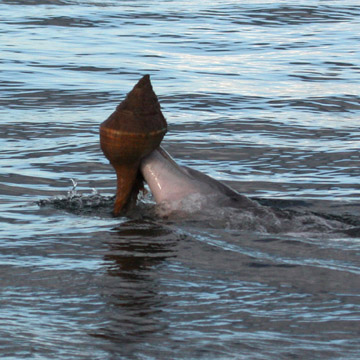A new fad may be sweeping through Shark Bay, off the coast of Western Australia: conching. Researchers have seen bottlenose dolphins there bring conch shells to the surface and dump out fish. And the behavior seems to be getting more common.
 A dolphin conching in Shark Bay. Credit: Dee McElligott ñ University of Zurich/Murdoch University.
A dolphin conching in Shark Bay. Credit: Dee McElligott ñ University of Zurich/Murdoch University. The dolphins in Shark Bay use some pretty crafty strategies to stir up a meal. One is called “kerplunking” — the dolphin slaps its tail on the surface above a seagrass bed to scare out the fish. Another is called “sponging” — the dolphin uses a sponge to protect its beak as it pokes around the bay floor.
Conching is another feeding strategy that involves tools. The dolphin grabs a conch shell in which a fish is hiding, and brings it to the surface. It then tilts the shell on its side, draining the water — and allowing the fish to drop into the dolphin’s mouth.
Conching was first seen in the mid-1990s, but it’s become more common in the last few years. Researchers say that probably means a few dolphins developed the technique independently, and others are starting to catch on. It could be passed from mother to calf, or simply copied by other dolphins who see their pals getting an easy snack. And it’s possible that it could become more common over the next couple of years, as more and more dolphins become “conchers.”
The researchers aren’t sure what happens before the dolphins come to the surface, though. The dolphins may simply grab a shell after they see a fish take cover there, or they may “herd” fish into empty shells — in effect, setting traps to catch a meal.

